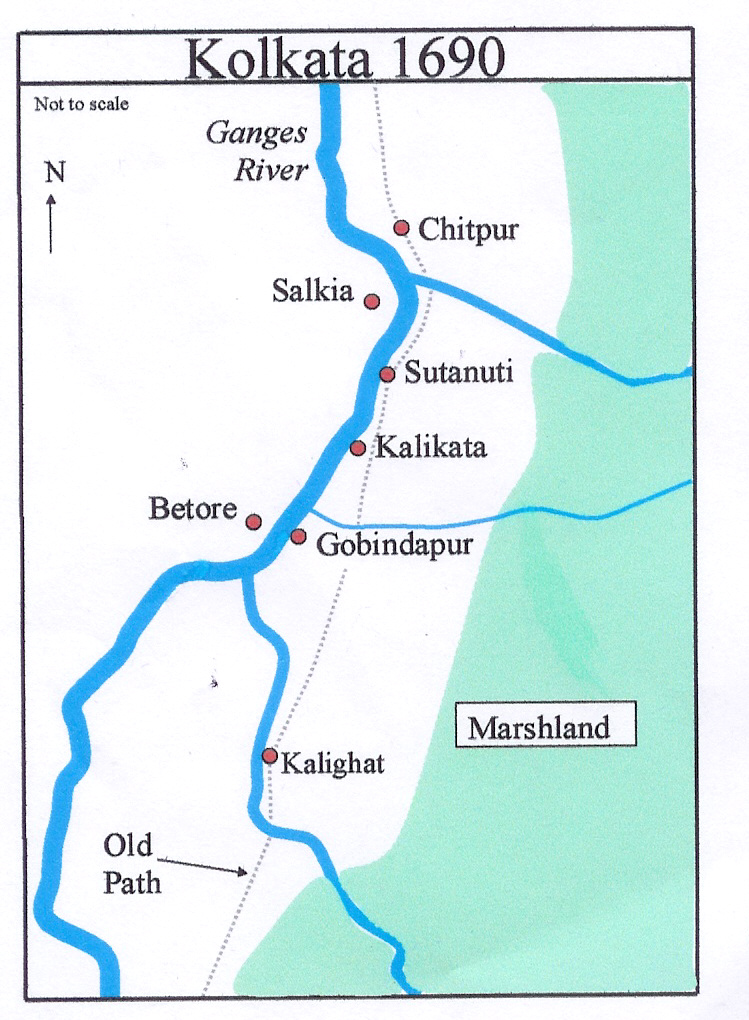Gobindapur, Kolkata on:
[Wikipedia]
[Google]
[Amazon]
Gobindapur was one of the three villages which were merged to form the city of Calcutta in late 17th century. The other two villages were Kalikata and Sutanuti. 
Job Charnock
Job Charnock (; –1692/1693) was an English administrator with the East India Company. He is commonly regarded as the founder of the city of Kolkata (formerly Calcutta); however, this view is challenged, and in 2003 the Calcutta High Court dec ...
, an administrator with the British East India Company is traditionally credited with the honour of founding the city. While Kalikata and Sutanuti lost their identity as the city grew, Gobindapur was demolished for the construction of new Fort William.

The foundations
When the Portuguese first started to frequent Bengal, around the year 1530, the two great centres of trade were Chittagong, which the Portuguese called Porto Grande or Great Haven, in the east and Satgaon, which the Portuguese called Porto Piqueno or Little Haven in the west. Tolly’s Nallah or Adi Ganga was then the outlet to the sea and ocean-going ships came up to around where Garden Reach is now, then the anchoring place for ships. Only country boats operated further up the river. Possibly the Saraswati river was another watery life line. It started drying up from the middle of the 16th century. The Portuguese built a new port at Hugli in 1580. There is another story regarding the foundation and naming of the village. Towards the end of the 16th century, the Indian merchant-princes of Port Piqueno were forced to seek another market for their trade. Most of them settled down in Hugli but four families of Basaks and one of Sheths, determined to profit by the growing prosperity ofBetor
Betore ( bn, বেতড়) was a major trading centre, the location being around present Shibpur in Howrah district in the Indian state of West Bengal.
In addition to the three recognised hamlets, Sutanuti, Gobindapur and Kalikata around wh ...
, founded the village of Gobindapur, on the east bank of the river.'' Gobindaji'' was the family deity of the Sheths and Basaks, and so they named the village Gobindapur.
In 1596, the place is mentioned as a district of the Sirkar (or government) of Satgaon, in the book ''Ain-e-Akbari
The ''Ain-i-Akbari'' ( fa, ) or the "Administration of Akbar", is a 16th-century detailed document recording the administration of the Mughal Empire under Emperor Akbar, written by his court historian, Abu'l Fazl in the Persian language. It for ...
'' by Abul Fazal Abul is an Arabic masculine given name. It may refer to:
* Abul Kalam Azad
* Abul A'la Maududi
* Abul Khair (disambiguation), several people
* Abul Abbas (disambiguation), several people
* Abul Hasan
* Abul Hasan Ali Hasani Nadwi
* Abu'l-Fazl ibn ...
, the prime minister of Akbar. As traders, the Portuguese were succeeded by the Dutch and finally the British.
English arrival
Job Charnock favoured Sutanuti as a settlement because of the security of the location. It was protected by the river on the west and by impassable marshes on the south and the east. Only the north-east had to be guarded. The three villages were part of the khas mahal or imperial jagir (an estate belonging to theMughal emperor
The Mughal emperors ( fa, , Pādishāhān) were the supreme heads of state of the Mughal Empire on the Indian subcontinent, mainly corresponding to the modern countries of India, Pakistan, Afghanistan and Bangladesh. The Mughal rulers styled ...
himself), whose zemindari rights were held by the Sabarna Roy Choudhury family of Barisha. On 10 November 1698, Job Charnock’s successor and son-in-law, Charles Eyere, acquired the land holding rights for the three villages from the Sabarna Roychoudhuris. The company paid regular rent to the Mughals for these villages till 1757. Within a short period Kolkata grew considerably.
New Fort William
Siraj ud-Daulah, the Nawab of Bengal, was alarmed by the growing prosperity and enhanced fortifications of Kolkata. In 1756, he decided to attack Kolkata and captured it. Gobindapur was fired by the English themselves. The English evacuees set up temporary quarters at Falta, downstream. What followed was a series of skirmishes finally leading to the Battle of Plassey on 23 June 1757 and the establishment of British power in Bengal. One of the first things that the English embarked upon on their return to Kolkata was the construction of new Fort William. It commenced in 1758 and completed in 1773. The site chosen was in the heart of ‘populous flourishing’ village of Gobindapur. A portion of the ‘restitution money’ was spent in compensating the inhabitants who were given lands in other parts of the town notably in Taltala, Kumortuli and Shobhabazar.References
See also
{{coord missing, West Bengal History of Kolkata Villages in Kolkata district